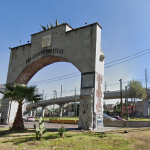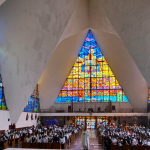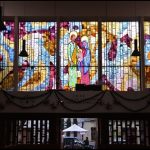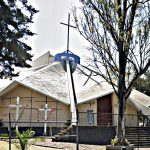
La Iglesia Parroquial de San Andrés Apóstol se encuentra en el antiguo barrio de Tomatlán. Puede verse mejor desde la plataforma de la estación del metro del vecindario en la línea 12. El papel de la iglesia en las festividades del vecindario, que se llevan a cabo durante todo el año, deja pocas dudas de su importancia histórica como lugar de encuentro para la comunidad.
La iglesia actual se comenzó a construir en 1979 con el objetivo de reemplazar una capilla local mucho más antigua. Una capilla original de San Andrés Apóstol, en este mismo lugar, fue registrada en una pintura de 1580. Dicho registro fue creado como parte de la Relación Geográfica, un conocido proyecto emprendido por la Corona Española para reunir datos de comunidades indígenas. El resultado fue que la totalidad de la ciudad más grande de Culhuacán es una de las ciudades mejor documentadas del siglo XVI.
La antigua capilla, demolida en la década de 1970, tenía cierto parecido con la Capilla del Señor del Calvario justo al norte del Centro de Culhuacán. Probablemente data de una época similar, es decir, finales del siglo XIX.
La obras de la nueva iglesia parroquial de San Andrés Apóstol se iniciaron en 1979, fueron terminadas a mediados de la década de 1980. y, en 1987, se volvió una iglesia parroquial. Su diseño hace eco de muchas otras iglesias parroquiales en su modernidad e incluso en sus extremos expresivos. Sin embargo, como todas las iglesias de Valle de México, también es 100% única.
Aparece una representación de la iglesia, no solo en el logotipo de la estación del Metro, sino en los arcos que dan la bienvenida a los visitantes al pueblo. Esto se encuentra en la intersección de Avenida Tláhuac y la Avenida Santa Ana, justo después del Puente del Toro que cruza el Canal Nacional.
 parrsantom@gmail.com
parrsantom@gmail.com
 55 5656 1429
55 5656 1429
 https://www.facebook.com/ParrSanAndresTomatlan/
https://www.facebook.com/ParrSanAndresTomatlan/

Cercano a 0.06 kms.

Cercano a 0.09 kms.

Cercano a 0.74 kms.

The most spectacular modernist church in the Jardín Balbuena

La construcción se inauguró en enero de 1967 y se ha convertido en un centro de oración para los vecinos de la zona.

A circular modernist church on the heights over Álvaro Obregón . . .

A modernist church in a giant 20th century neighborhood . . .

A modernist triumph and neighborhood church in Espartaco, Coyoacán . . .